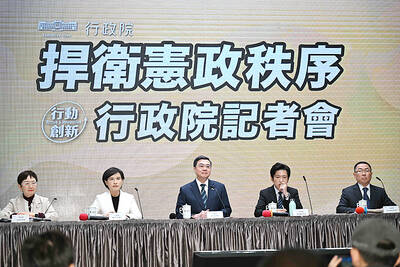The Chinese Ministry of Foreign Affairs has defended the government’s decision to build lighthouses on disputed islands in the South China Sea, saying the facilities are to help navigation.
Chinese media outlets reported on Thursday that the country is planning to build lighthouses on five islands in the South China Sea.
The islands are known as North Reef (北礁), Antelope Reef (Lingyang Reef, 羚羊礁), Drummond Island (Jincing Island, 晉卿島), South Sand (南沙洲) and Pyramid Rock (Gao Jianshih, 高尖石), all of which Taiwan also claims, and include two that appear to be in waters also claimed by Vietnam.
Ministry spokeswoman Hua Chunying (華春瑩) said in a statement posted on the ministry’s Web site late on Friday that the lighthouses were “necessary measures to guarantee the safety of vessel traffic” and were both in the public’s interest and compliant with international law.
The US and the Philippines have called for a voluntary freeze on any “status quo” changing moves by disputants in the area, but China has rejected the proposal.
Washington is also attempting to use this weekend’s ASEAN regional forum in Myanmar to lobby foreign ministers from Southeast Asian nations to pressure China to come to the negotiating table.
China claims 90 percent of the South China Sea and has recently begun to aggressively enforce its territorial claims.
In May, China moved an oil rig into waters disputed by Taiwan and Vietnam, backed up by a flotilla of warships and fishing boats, which resulted in a Vietnamese fishing vessel being sunk and anti-Chinese riots erupting in Vietnam.
The Philippines has also accused China of building a landing strip on a shoal it claims as part of its territory. Taiwan also claims the shoal.
The Xinhua news agency reported yesterday that Chinese Minister of Foreign Affairs Wang Yi (王毅) met his counterparts from some Southeast Asian countries, including Vietnam, on the sidelines of the summit in Myanmar.
Wang told Vietnamese Minister of Foreign Affairs Pham Binh Minh that China would take “all necessary means to safeguard national sovereignty and maritime rights and interests,” and urged Vietnam to properly deal with the aftermath of the anti-China riots, the report said.

The US government has signed defense cooperation agreements with Japan and the Philippines to boost the deterrence capabilities of countries in the first island chain, a report by the National Security Bureau (NSB) showed. The main countries on the first island chain include the two nations and Taiwan. The bureau is to present the report at a meeting of the legislature’s Foreign Affairs and National Defense Committee tomorrow. The US military has deployed Typhon missile systems to Japan’s Yamaguchi Prefecture and Zambales province in the Philippines during their joint military exercises. It has also installed NMESIS anti-ship systems in Japan’s Okinawa

‘WIN-WIN’: The Philippines, and central and eastern European countries are important potential drone cooperation partners, Minister of Foreign Affairs Lin Chia-lung said Minister of Foreign Affairs Lin Chia-lung (林佳龍) in an interview published yesterday confirmed that there are joint ventures between Taiwan and Poland in the drone industry. Lin made the remark in an exclusive interview with the Chinese-language Liberty Times (the Taipei Times’ sister paper). The government-backed Taiwan Excellence Drone International Business Opportunities Alliance and the Polish Chamber of Unmanned Systems on Wednesday last week signed a memorandum of understanding in Poland to develop a “non-China” supply chain for drones and work together on key technologies. Asked if Taiwan prioritized Poland among central and eastern European countries in drone collaboration, Lin

NO CONFIDENCE MOTION? The premier said that being toppled by the legislature for defending the Constitution would be a democratic badge of honor for him Premier Cho Jung-tai (卓榮泰) yesterday announced that the Cabinet would not countersign the amendments to the local revenue-sharing law passed by the Legislative Yuan last month. Cho said the decision not to countersign the amendments to the Act Governing the Allocation of Government Revenues and Expenditures (財政收支劃分法) was made in accordance with the Constitution. “The decision aims to safeguard our Constitution,” he said. The Constitution stipulates the president shall, in accordance with law, promulgate laws and issue mandates with the countersignature of the head of the Executive Yuan, or with the countersignatures of both the head of the Executive Yuan and ministers or

CABINET APPROVAL: People seeking assisted reproduction must be assessed to determine whether they would be adequate parents, the planned changes say Proposed amendments to the Assisted Reproduction Act (人工生殖法) advanced yesterday by the Executive Yuan would grant married lesbian couples and single women access to legal assisted reproductive services. The proposed revisions are “based on the fundamental principle of respecting women’s reproductive autonomy,” Cabinet spokesperson Michelle Lee (李慧芝) quoted Vice Premier Cheng Li-chiun (鄭麗君), who presided over a Cabinet meeting earlier yesterday, as saying at the briefing. The draft amendment would be submitted to the legislature for review. The Ministry of Health and Welfare, which proposed the amendments, said that experts on children’s rights, gender equality, law and medicine attended cross-disciplinary meetings, adding that